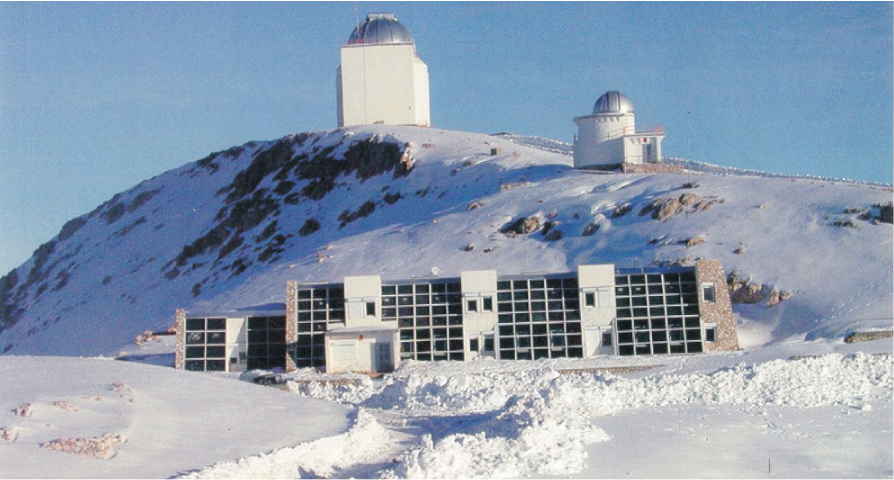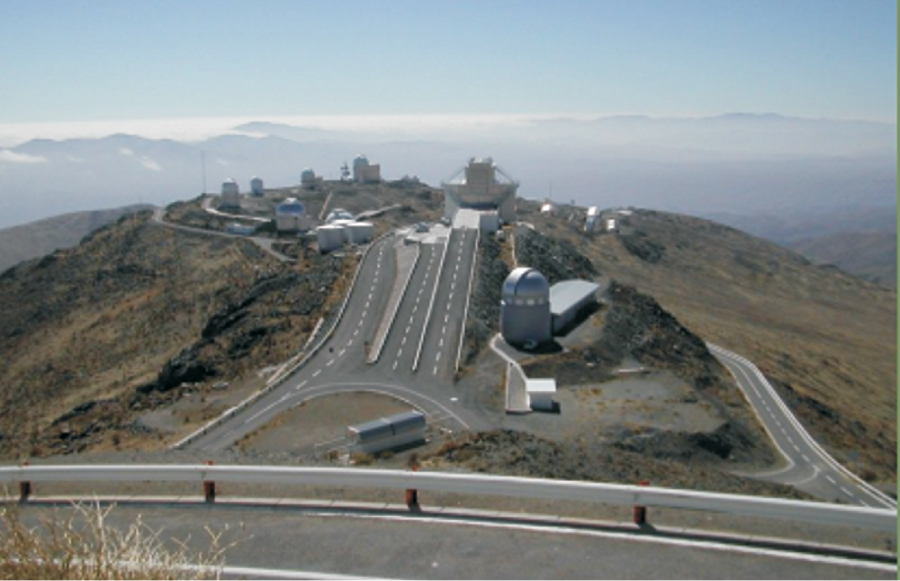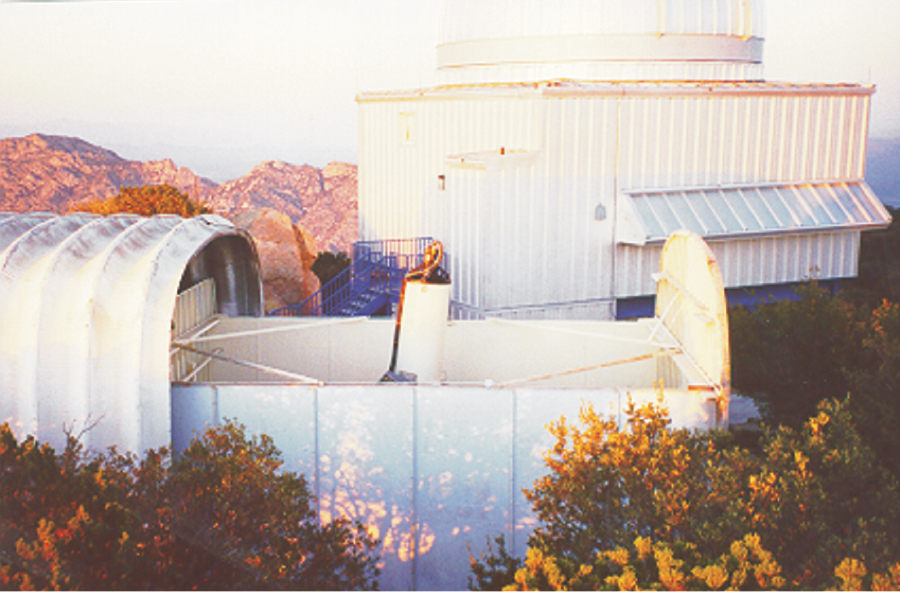Search for Optical Gamma-Ray Burst Signals Ratchets Up
DOI: 10.1063/1.1506742
Triggered by a satellite signal, the telescope slews across the sky and zeroes in on a gamma-ray burst, capturing the explosion’s optical emissions within seconds. That, at least, is the plan. So far, though, it has played out like that just once, on 23 January 1999. The tantalizing GRB990123 has stoked scientists’ enthusiasm, and several experiments using small, ground-based, robotic telescopes to tackle big questions about gamma-ray bursts are in the works.
Their edge is speed: By rushing to the scene, these telescopes stand a chance of revealing the physics of “the biggest bangs since the Big Bang,” says Bradley Schaefer, an astrophysicist at the University of Texas at Austin and a member of the Robotic Optical Transient Search Experiment (ROTSE). Large telescopes have a much slower response time, and are left staring hours later at the afterglow, which can yield the distance to gamma-ray bursts and information about their interactions with the interstellar medium, but nothing about what causes a burst (see page 18
Robotic burst hunters
The coup of catching GRB990123 catapulted ROTSE to the fore among experiments designed to study early optical signals from gamma-ray bursts. And, with telescopes slated to come online in the next few months at four sites—near Coonabarabran, Australia; Mt. Gamsberg, Namibia; Mt. Bakirlitepe, Turkey, and in the US, at McDonald Observatory in western Texas—the newest version of ROTSE is perhaps the most ambitious such project. “We would like to have telescopes on the night sky all the time. That’s why we wanted them spread as widely as possible,” says Carl Akerlof, the University of Michigan particle physicist-turned-astrophysicist who has spearheaded ROTSE.
In addition to ROTSE, other telescopes seeking early optical signals from gamma-ray bursts include LOTIS (Livermore Optical Transient Imaging System) in Livermore, California, and Super-LOTIS on Kitt Peak, Arizona; the French TAROT (Télescope à Action Rapide pour les Objets Transitoires), with a telescope in the French Alps and one planned for La Silla, Chile, which will also host the Italian REM (Rapid Eye Mount); and the French ARAGO (Advanced Robotic Agile Observatory), with telescopes planned in France and on Spain’s Canary Islands. In each case, the telescopes are fully robotic: Their protective housings open and close after automatically checking light, humidity, rain, and wind conditions, and the telescopes respond to the same satellite triggers, which are distributed over the Internet. The telescopes differ in their software, sensitivity, wavelength range, and speed; and REM is the only one that will do spectroscopy. “These instruments are not all that different,” says Akerlof. “The sum of knowledge will come from adding them all up.”
The new generation of ground-based telescopes for chasing gamma-ray bursts have mirror diameters ranging from 25 cm (TAROT) to 1.5 m (ARAGO) and sensitivities from 18th to 20th magnitude (on this logarithmic scale, GRB990123 was visible at 9th magnitude, or about 15 times fainter than the naked eye can see). Most of these telescopes can train their eyes on the site of a burst in less than 10 seconds (30 seconds for Super-LOTIS), and they cost from $100 000 (TAROT) to $600 000 (REM). Super-LOTIS came online in 2000 and LOTIS and earlier versions of TAROT and ROTSE have been lying in wait for gamma-ray bursts for several years. The new telescopes are slated to come online by early next year, except for ARAGO, which will follow in 2004.
Faster than swift
Given all the surveillance, why haven’t more gamma-ray bursts been seen from the ground? One obvious impediment is the dearth of satellite triggers. “We’re down to about one a month,” says Akerlof. And even those have come too late to catch early emissions. The Compton Gamma Ray Observatory, which found GRB990123, was killed in May 2000. Since then, triggers have come mainly from the Italian-Dutch satellite BeppoSAX, which was deactivated on 30 April, and from the MIT-led international HETE-2 (High Energy Transient Explorer). As intended, these satellites gave more precise positions than CGRO, allowing the ground-based gamma-ray burst hunters to narrow and deepen their fields of view. But so far, the satellites’ triggers have arrived too late to observe a gamma-ray burst in action. “The interesting thing is what happens at very early times,” says Akerlof. “GRB990123’s optical signal was up and down in one minute.”
Now scientists have their sights pinned on Swift, a NASA satellite scheduled for launch in September 2003. Swift is expected to spot a gamma-ray burst every two to three days. For any given ground-based telescope, that means one every two weeks on average, says Schaefer—given roughly even odds of a particular burst occurring at night, in the accessible part of the sky, and during clear weather.
Ironically, the satellite could trump the ground-based telescopes: It will itself observe gamma-ray bursts at optical wavelengths. “Swift won’t get all of them,” says Schaefer, a member of the Swift team. But, he admits, the ground-based telescopes will have to find their own niches. Swift will need 85 seconds to point its optical detector, says Schaefer. “Carl [Akerlof] is faster than Swift. So ROTSE’s—and the other ground-based telescopes’—domain is 10–85 seconds.”
In what could turn out to be a particularly fruitful niche, REM’s detection—and perhaps eventually Super-LOTIS’s—will extend into the infrared. One possible explanation for why the early optical signal has been so evasive is that gamma-ray bursts may occur mostly in star-forming regions, where dust would absorb optical wavelengths. “We will certainly detect a large number of these dark bursts,” says REM project scientist Guido Chincarini of the University of Milan-Bicocca. Even more enticing, he adds, is the prospect of detecting extremely distant gamma-ray bursts, whose visible light is redshifted into the infrared. “These bursts could be as far away as the reionization epoch, or further. If we catch only one of these—that is the real dream—it will be the event of the decade.”
When they are not homing in on a gamma-ray burst, REM, ROTSE, and their kin will scan the skies, stocking up wide-field images that can be trolled for variable stars, active galactic nuclei, quasars, and other variable and transient celestial objects. “This all-sky record of variability is one of the unheralded things about ROTSE,” says Schaefer, who, as a graduate student 20 years ago was one of the first people to look for optical counterparts to gamma-ray bursts, poring over some 50 000 photographic plates at Harvard University. In the 1980s, after nearly a century, Harvard stopped collecting the plates, adds Schaefer. “ROTSE data will fill this gap.”
The small telescopes can also alert their bigger brethren about gamma-ray bursts and other transient phenomena. For example, spectra are needed to determine astronomical distances. “We can’t do spectroscopy, but we can help others who do,” says Akerlof. “Usually, it takes four to eight hours to recognize that something actually was a gamma-ray burst. If we can recognize rapid variations fast, that’s a better smoking gun. If you can catch it within an hour or two, you have a reasonable chance of doing spectroscopy with a 1- or 2-meter telescope; if you wait a day, the signal fades and you have to use an 8-meter class telescope.” Accordingly, TAROT and REM will coordinate with their neighbor, the Very Large Telescope; the ROTSE telescope in Namibia will work closely with the nearby High Energy Stereoscopic System (see Physics Today, June 2000, page 50
The field of gamma-ray bursts is changing incredibly fast, says Schaefer. “Before 1997, when measurements of the optical afterglow first gave the distance to a gamma-ray burst, the uncertainty in the distance was 12 orders of magnitude. Horrifying! The energy was uncertain to 24 orders of magnitude. Horrible! Can you think of anything less well known than that?”

The National Observatory of Turkey (TUG), located in the mountains rising above the country’s southern coast, will host one of the four telescopes that make up the Robotic Optical Transient Search Experiment. ROTSE in Turkey is scheduled to start sky-gazing in October.
CARL AKERLOF


The Family of Telescopes at the European Southern Observatory on La Silla, Chile, will expand by two this fall, with the additions of Italy’s Rapid Eye Mount and France’s Télescope à Action Rapide pour les Objets Transitoires. Among telescopes seeking early signs of gamma-ray bursts, REM is the only one equipped to detect in the infrared.
GUIDO CHINCARINI AND FILIPPO ZERBI


From Kitt Peak, Arizona, Super-LOTIS (Super Livermore Optical Transient Imaging System) has been on the lookout for the optical counterparts to gamma-ray bursts since October 2000.
GEORGE GRANT WILLIAMS

More about the Authors
Toni Feder. tfeder@aip.org
